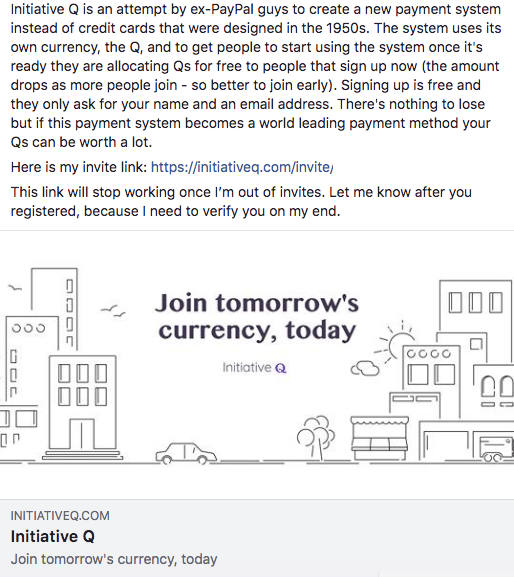
What Is Initiative Q? By now, you’ve most likely seen what many people are touting to be the next big payment network. Or according to others, the next big scam. Whether you’re deep in the cryptosphere or not, the following message has probably come across your Facebook newsfeed at one time or another:
One of Many Initiative Q Referral Posts
It’s an enticing offer. Just sign up with your name and email address. In return, you get free Q, the new currency of the future. Navigate to the home page, and you’ll see that the value of signing up now is estimated to be worth thousands of dollars once the network is live.
If you think this sounds too good to be true, you’re not alone. The company has received a wide array of criticism alongside the proponents who argue that you’ve got nothing to lose in trying it out. So to help you out, we’re taking Initiative Q to trial, analyzing some of the company’s most bold claims.
CoinCentral Court is now in session.
Claim #1: You’ll Earn Thousands Through Registration
The Initiative Q homepage touts in big, bold letters that signing up today is worth an estimated value of over $15,000. Note the bolding.

Initiative Q makes some bold claims.
Under that, in much smaller, lighter lettering, are a couple of critical assumptions. Let’s check those out one by one.
#1: One Q = One USD
The first assumption is that each Q will have a value of one USD. Here’s how they come to that valuation:
- Credit cards account for $20 trillion in annual transactions.
- The total amount of money in the world is around half of the world’s economic activity.
- Therefore, with Q replacing credit cards, the total value of all Q is $10 trillion.
- Two trillion Q currently exist, so even with only one-fifth of the planned adoption, each Q will be worth one dollar.
Confused yet?
There are a few holes in this rationale. The biggest red flag is that credit cards don’t actually account for $20 trillion in annual transactions. That figure represents the annual transaction amount of all cards (debit, credit, and prepaid), not just credit cards. In fact, debit cards make up the majority of this number.
Strike one.
The comparison of Q to credit cards is also a stretch. The website doesn’t contain any wording regarding lines of credit or interest rates. Instead, they compare their distribution of initial Q to the way in which the first credit cards gained popularity. To solve the chicken-or-egg problem of credit card adoption, BankAmericard shipped their cards to 60,000 residents of Fresno. Because so many residents now had a card, they could easily convince merchants to accept it.
That comparison falls apart for Initiative Q, however. Residents that used their BankAmericard still had to pay off their balance. They didn’t receive free money.
Strike two.
Finally, obtaining adoption in one-fifth of the market will be difficult. With the head start of other equal, if not better, payment solutions like Bitcoin and traditional mobile payments, Initiative Q could easily get stuck behind in a constant game of catch-up.
Strike three; you’re out.
#2: You Must Complete Additional Tasks to Receive your Q
The second, slightly hidden catch is that you earn just ten percent of your allocated Q after sign-up. You receive an additional forty percent only after inviting five friends.
As for the remaining half? You’ll need to perform some set of future tasks to receive them. It’s anyone’s guess as to what those will be.
The Verdict – Guilty
The estimated Initiative Q reward contains too many overly confident assumptions to be considered realistic. Considering the overestimation of the market size and adoption percentage and the extra hoops you’ll likely have to jump through, don’t expect to receive the entire amount.
This marketing strategy is a brilliant way to earn brand recognition and potential users – even if it is slightly deceitful.
Claim #2: Ex-PayPal Guys Started Initiative Q
This exact wording doesn’t appear on the website. However, it appears right at the top of the Facebook post the company encourages you to share when signing up. Here it is again in case you haven’t seen it enough.
“ex-PayPal guys”
Let’s dig into the team some. The Initiative Q website only lists one team member – founder Saar Wilf. Here are the facts:
- Wilf founded a payment security company, Fraud Sciences. Dubious name, we know.
- In 2008, PayPal acquired Fraud Sciences for $169 million.
- According to his LinkedIn profile, Wilf served as Director at PayPal for two years.
Wilf has also been active as the Chairman of several companies’ boards, including six of which he is still active. Calling him an “ex-PayPal guy,” although technically right, is misleading.
The website also states that Wilf worked with economist Lawrence H. White to develop the network’s monetary models. There is no reason to doubt this fact. White even mentions Initiative Q in his article Bitcoin After 10 Years, describing it as:
“not a cryptocurrency governed by a program, but a private non-commodity money whose quantity is governed by a human board that pledges to stabilize its purchasing power.”
White is a paid consultant for the company. Take that as you will.
The Verdict – Innocent
It’s clear that legitimate people are operating Initiative Q, and they have impressive resumes. The team doesn’t exactly live up to the claim of “ex-PayPal guys,” but let’s once again chalk up the discrepancy to clever marketing.
Claim #3: Initiative Q is an Improvement on Cryptocurrency (And Traditional Payment Systems)
Out of all the claims, this is the most subjective one. And, if we’re honest, we have a slight bias towards a guilty ruling. We’ll try to take an objective look at each argument separately, though.
Initiative Q > Cryptocurrency
Initiative Q has an entire section of their FAQ section dedicated to how it’s better than cryptocurrency. Except, they only debate one benefit of crypto, ignoring the rest of the value it brings.
They argue that cryptocurrency is just “digital money that is hard to counterfeit,” solving a problem that doesn’t exist. The website fails to mention its censorship-resistance and ability to enable self-sovereignty through a trustless system. But, let’s not get bogged down in the details.
Other falsehoods that Initiative Q presents include:
- Bitcoin supports just two transactions per second. Bitcoin averages seven transactions per second, and if you analyze any random day with significant transaction volume, you can see it’s accomplished well over two. These numbers are all without second layer scaling implementations as well.
- Cryptocurrencies have either no monetary policy or an overly simplistic one. Neither parts of this statement are correct. All cryptocurrency has some type of monetary policy in place (no inflation is still a monetary policy). And many cryptocurrencies have complex monetary systems. What’s simple is that these fiscal policies are set in stone through programming outside the control of irrational human decision making.
- Cryptocurrency users are expected to undertake complicated security procedures such as:
- generating cryptographic keys using dice,
- entering them into an unused laptop that is later destroyed,
- storing the keys using special hardware from multiple manufacturers,
- and keeping paper backups in bank safes.
We don’t need to explain how this process is a clear over-generalization.
To the credit of the Initiative Q team, they did accurately bring up a few legitimate criticisms of cryptocurrency like its energy consumption, unstable value, and irreversibility. Although that last one may be something positive depending on who you talk to.
The Initiative Q team attempts to distance their currency so far from cryptocurrency that it’s difficult to tell where the value-add is over traditional currencies. Which brings us to our final question.
How Is Initiative Q Different Traditional Monetary Systems?
To answer this question, it’d be best to pull quotes directly from the Initiative Q site.
“The committee will only issue new coins for the purpose of maintaining stability, and increasing adoption — similar to how the world’s largest currencies are managed.”
“Transaction information on the Q payment network will be handled similarly to how current payment and banking networks operate…”
“Companies like Apple, Google and Amazon have developed such features, but they are still used in a small fraction of transactions.”
You probably get the picture by now. Initiative Q seems to be taking all the separate parts of a traditional financial system and…doing nothing but combining them again.
The Verdict – Guilty
It’s a difficult task to figure out precisely what Initiative Q is. The company is positioning itself as an improvement to current payment systems without really giving details on how that’s true. It’s a centrally controlled monetary system using many of the same principles as banks and technology that already exist in the market.
And, in case they didn’t hammer this point in enough, it’s definitely not a cryptocurrency. (Although cryptocurrency “may be deployed in Initiative Q’s backend, for settlement between Q agents.”)
Conclusion – Is Initiative Q Legit?
After looking at the evidence, we can conclude that Initiative Q probably isn’t a scam, per se. However, this verdict doesn’t mean that the project is in any way legitimate.
The most prominent feature that Initiative Q promotes is the integration of cash and card functionality into a smartphone. We agree this is a great idea. Only, it already exists (Apple Pay, Samsung Pay).
All Initiative Q seems to be doing is further digitizing our current financial system while muddying it up through a worthless currency and questionable marketing tactics. The team isn’t even planning on building the network until mid-2019, and only if it gets significant traction before then.
In the end, the choice to sign up is your own. But we’re confident that down the line, it’ll be much more than your name and email address you’ll be giving up.
The post Putting Initiative Q on Trial | The Next Big Thing or Complete Scam? appeared first on CoinCentral.

Coincentral.com is author of this content, TheBitcoinNews.com is is not responsible for the content of external sites.
Our Social Networks: Facebook Instagram Pinterest Reddit Telegram Twitter Youtube










